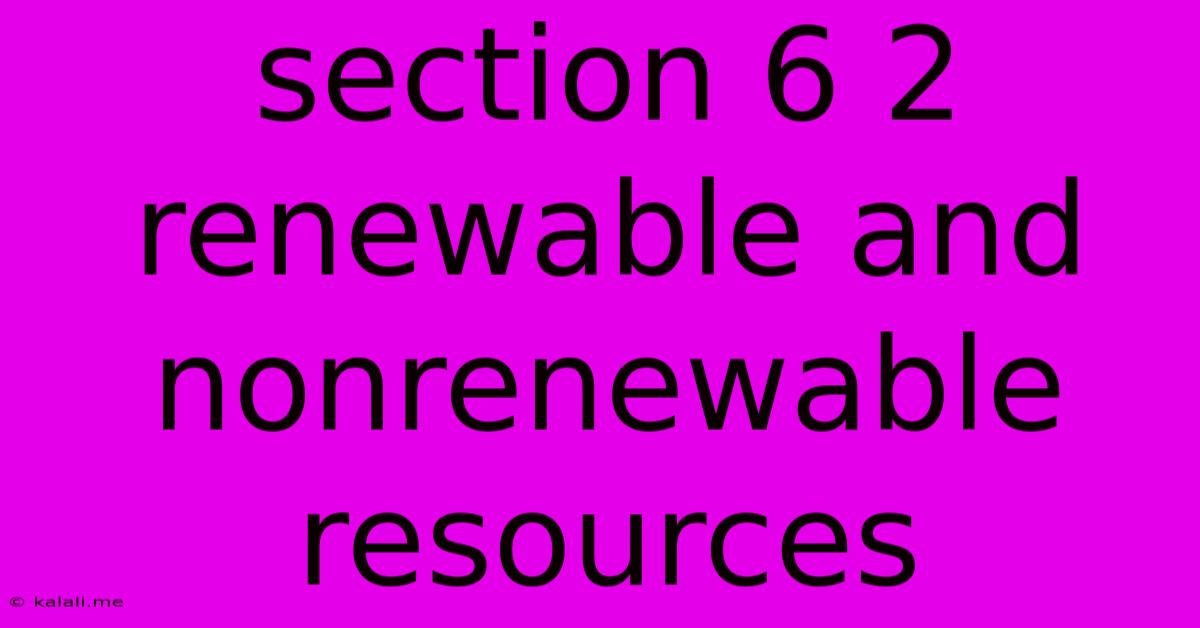Section 6 2 Renewable And Nonrenewable Resources
Kalali
May 10, 2025 · 4 min read

Table of Contents
Section 6.2: Renewable and Non-Renewable Resources: A Deep Dive
This article explores the crucial distinction between renewable and non-renewable resources, examining their characteristics, impacts, and the importance of sustainable resource management. Understanding this difference is vital for navigating the complexities of environmental science and informing responsible resource consumption. We'll delve into specific examples and discuss the implications for future generations.
Renewable resources are naturally replenished at a rate equal to or faster than their consumption. This means they can be used sustainably without depleting the source. Non-renewable resources, conversely, are consumed at a rate faster than they are replenished, leading to eventual depletion. The consequences of over-relying on non-renewable resources are profound and far-reaching, impacting not only the environment but also economic stability and social equity.
Types of Renewable Resources: A Closer Look
Several key categories fall under the umbrella of renewable resources:
-
Solar Energy: Harnessing the sun's power through photovoltaic cells or concentrated solar power plants is a rapidly expanding sector. Solar energy offers a clean, abundant, and sustainable alternative to fossil fuels. Technological advancements continue to improve efficiency and reduce costs, making solar power increasingly accessible.
-
Wind Energy: Wind turbines convert kinetic energy from wind into electricity. Wind energy is a clean and sustainable source, particularly effective in areas with consistent wind patterns. Offshore wind farms are becoming increasingly significant due to their higher wind speeds and reduced land use impacts.
-
Hydropower: Using the power of moving water to generate electricity is a well-established renewable energy technology. Hydropower plants harness the potential energy of water stored behind dams, converting it into electricity through turbines. While effective, hydropower projects can have significant environmental impacts on river ecosystems.
-
Geothermal Energy: Harnessing heat from the Earth's interior, geothermal energy offers a stable and reliable source of renewable energy. Geothermal power plants use steam or hot water from underground reservoirs to generate electricity. This technology is particularly suitable for regions with high geothermal activity.
-
Biomass Energy: Burning organic matter, such as wood, crops, or waste, to generate energy is a form of biomass energy. While renewable, sustainable biomass energy requires careful management to avoid deforestation and soil degradation. Advanced biofuels are also being developed to reduce reliance on fossil fuels in the transportation sector.
Types of Non-Renewable Resources: Understanding the Limitations
Non-renewable resources are finite, meaning their supply is limited and cannot be replenished within a human timescale. The most prominent examples include:
-
Fossil Fuels (Coal, Oil, and Natural Gas): These resources formed over millions of years from the remains of ancient organisms. Their combustion releases greenhouse gases, contributing significantly to climate change. The depletion of fossil fuels is a major concern, driving research into alternative energy sources.
-
Nuclear Fuels (Uranium): Used in nuclear power plants, uranium is a non-renewable resource. While nuclear power generates low-carbon electricity, concerns remain about nuclear waste disposal and the potential for accidents.
-
Minerals and Metals: Various minerals and metals are essential for manufacturing and construction. Mining these resources can have significant environmental impacts, including habitat destruction and pollution. Recycling and responsible sourcing are crucial for minimizing these impacts.
The Importance of Sustainable Resource Management
The transition to a sustainable future requires a shift away from over-reliance on non-renewable resources and a greater emphasis on renewable energy sources. Efficient resource management, conservation strategies, and technological innovation are all crucial components of this transition. This includes:
-
Reducing Consumption: Minimizing waste and promoting a circular economy, where materials are reused and recycled, is essential.
-
Improving Efficiency: Developing technologies that maximize the use of resources while minimizing waste is crucial for sustainability.
-
Investing in Renewables: Significant investment in renewable energy infrastructure is essential to reduce dependence on fossil fuels.
-
Promoting Conservation: Protecting natural resources and ecosystems is vital for maintaining the long-term availability of renewable resources.
In conclusion, the distinction between renewable and non-renewable resources is fundamental to understanding environmental challenges and crafting effective solutions. Sustainable resource management strategies are paramount for ensuring the availability of resources for future generations and mitigating the environmental impacts of resource extraction and consumption. By embracing renewable energy sources and adopting responsible consumption patterns, we can work towards a more sustainable and equitable future.
Latest Posts
Latest Posts
-
Words That Start With Y In Science
Jul 12, 2025
-
Prevent An Expressway Emergency By Merging Without
Jul 12, 2025
-
How Many Grams Of Sugar In A Pound
Jul 12, 2025
-
7am To 11am Is How Many Hours
Jul 12, 2025
-
If Your 35 What Year Was You Born
Jul 12, 2025
Related Post
Thank you for visiting our website which covers about Section 6 2 Renewable And Nonrenewable Resources . We hope the information provided has been useful to you. Feel free to contact us if you have any questions or need further assistance. See you next time and don't miss to bookmark.